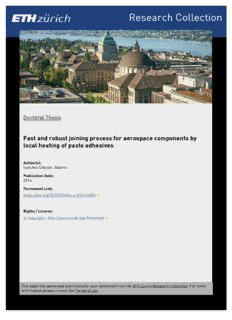
fast and robust joining process for aerospace components by local heating of paste adhesives PDF
Preview fast and robust joining process for aerospace components by local heating of paste adhesives
ETH Library Fast and robust joining process for aerospace components by local heating of paste adhesives Doctoral Thesis Author(s): Sánchez Cebrián, Alberto Publication date: 2014 Permanent link: https://doi.org/10.3929/ethz-a-010164453 Rights / license: In Copyright - Non-Commercial Use Permitted This page was generated automatically upon download from the ETH Zurich Research Collection. For more information, please consult the Terms of use. DISS.-No. ETH 21842 FAST AND ROBUST JOINING PROCESS FOR AEROSPACE COMPONENTS BY LOCAL HEATING OF PASTE ADHESIVES ALBERTO SÁNCHEZ CEBRIÁN 2014 DISS.-No. ETH 21842 FAST AND ROBUST JOINING PROCESS FOR AEROSPACE COMPONENTS BY LOCAL HEATING OF PASTE ADHESIVES A thesis submitted to attain the degree of DOCTOR OF SCIENCES OF ETH ZÜRICH (Dr. sc. ETH Zürich) presented by ALBERTO SÁNCHEZ CEBRIÁN Dipl. Industrial Engineer Universitat Politècnica de Catalunya (2009) born 20.07.1985 citizen of Spain accepted on the recommendation of Prof. Dr. Paolo Ermanni, examiner Dr. Markus Zogg, co-examiner Prof. Dr. Heinz Voggenreiter, co-examiner 2014 Allá donde estés, esto va por ti. i ii Summary (English) Since the 70s, industry is doing research in new adhesive sys- tems for joining composites for structural applications. Adhe- sive bonding permits having lighter structures and thus more efficient solutions than today’s aerospace state of the art, rivet- ing. Additionally, the use of adhesives does not require drill- ing the components, which is especially beneficial for joining composite materials. Typically, the curing of paste adhesives is carried out in forced convection ovens, applying isothermal heating cycles recom- mended by the supplier. The variation of the curing tempera- ture during the process is today not considered due to its high energy consumption. To avoid this limitation, the use of in- duction heating to heat locally the bondline is considered in this doctoral thesis. This technique allows heating the assem- bly faster and thus saving energy resources and time. In this context, the acceleration of the curing process of a paste adhe- sive by increasing the heating temperature during the process is investigated. However, the increment of the curing temperature leads to void formation and thus to the thermal degradation of the paste adhesive. This phenomenon is caused by the evapora- tion of moisture, the degradation of chemical components and the expansion of air trapped during the mixing process. The increment of void content affects the mechanical performance of the bonded system. To deal with this limitation, a novel modeling of the void formation during the curing process con- sidering the degree of cure is developed in this doctoral thesis. The fundamental idea of this approach is that the evaporation of the paste adhesive that leads to void formation decreases iii with curing progression. Therefore, a novel thermal degrada- tion model for the evaporation of paste adhesives is defined as a function of temperature, time and the degree of cure. Once the mass evaporation is modeled, the relation between evapo- rated mass and void formation is experimentally established, completing the void prediction model for paste adhesives. This model is then used to find the optimal strategy to acceler- ate the curing process of paste adhesives without increasing the void formation. This approach is applied to two different paste adhesive systems in order to ensure the repeatability of the research findings. The results show a reduction of more than 85 % of the processing time compared to the reference curing cycle without affecting the mechanical performance of the joint. Finally, the methodology investigated is applied to a real aircraft component, defining the guidelines to ensure the robustness of the process under real component geometries. iv Zussammenfassung (Deutsch) Seit den siebziger Jahren forscht die Industrie an neuen Klebstoffsystemen zur Verbindung von Faserverbunden für Strukturanwendungen. Kleben erlaubt leichtere Strukturen und damit effizientere Lösungen als der heutige Standard in der Luft- und Raumfahrt, das Nieten. Zudem erfordert die Verwendung von Klebstoff kein Bohren der Komponenten, was besonders vorteilhaft für das Fügen von Faserverbundwerkstoffen ist. Typischerweise wird das Aushärten von Pastenklebstoffen in Öfen mit erzwungener Konvektion durchgeführt, wobei vom Hersteller empfohlene Heizzyklen zur Anwendung kommen. Die Änderung der Aushärtetemperatur während des Prozesses wird heutzutage wegen ihres hohen Energieverbrauchs nicht berücksichtigt. Um diese Beschränkung zu überwinden, wird in dieser Doktorarbeit die Anwendung induktiven Heizens betrachtet, um die Klebenaht lokal zu erwärmen. Diese Technik erlaubt schnelleres Aufheizen und damit Ersparnisse an Ressourcen und Zeit. In diesem Kontext wird die Beschleunigung des Aushärteprozesses eines Pastenklebstoffs durch Erhöhung der Heiztemperaturen während des Prozesses untersucht. Die Steigerung der Aushärtetemperatur führt jedoch zu Porenbildung und damit zur thermischen Degradation des Klebers. Dieses Phänomen wird durch die Verdunstung von Feuchtigkeit, die Degradation chemischer Komponenten und die Ausdehnung während des Mischvorgangs eingeschlossener Luft verursacht. Die erhöhte Porenkonzentration beeinträchtigt die mechanischen Eigenschaften der Klebeverbindung. Um mit dieser Beschränkung umzugehen, wird in dieser Dissertation eine neuartige Modellierung der Porenbildung während des v
Description: